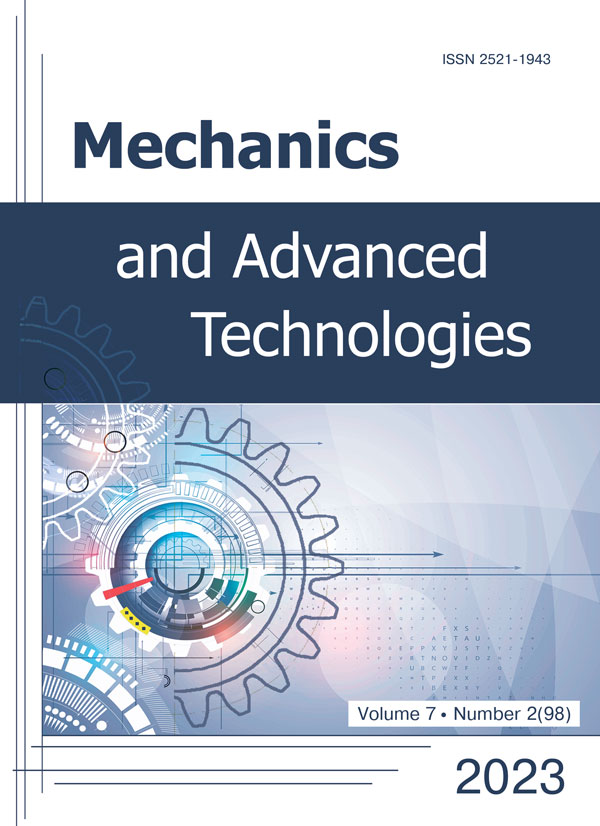Monitoring of the plastic state by changing of a deformation sign
DOI:
https://doi.org/10.20535/2521-1943.2023.7.2.274471Keywords:
plastic state, proportional load, non-monotonicity of deformation, material fibersAbstract
When a body element is proportionally loaded, its differently oriented material fibers can stretch, compress or not change their length. The direction of material fibers that do not change their length is neutral. Neutral direction divides compressed and stretched directions of the fibers. Within the limits of elasticity, the neutral direction does not change its orientation, and beyond the limit of elasticity, it rotates relative to the material fibers. Some material fibers, the slope of which is close to neutral, can change their deformation sign, and this change indicates that the element of the body has reached the plastic state.The proposed technique of the plastic state monitoring is demonstrated on a uniaxial stress state. The non-monotonicity of the close to the neutral direction material fiber deformation that oriented is confirmed by calculations and in an experiment on the tension of cylindrical specimen.The proposed technique allows fix plastic state of the material at proportional loading without value deformations or stresses measuring but by changing the sign of the deformation of the material fibers, the slope of which is close to the neutral direction.
References
- A. A. Lebedev, B. I. Kovalchuk, F. F. Giginyak and V. P. Lamashevskiy, Mekhanicheskiye svoystva konstruktsionnykh materialov pri slozhnom napryazhennom sostoyanii: Spravochnik. Kyiv: Naukova dumka, 1983, 367 p.
- G. S. Pisarenko, A. P. Yakovlev and V. V. Matveyev, Spravochnik po soprotivleniyu materialov. Kyiv: Naukova dumka, 1988, 736 p.
- N. N. Tormakhov, “Yield limit dependence of titanic alloy VТ14 from the stress state parameters”, Mechanics and Advanced Technologies, vol. 84, no. 3(84), pp. 91–97, 2018. DOI: https://doi.org/10.20535/2521-1943.2018.84.127194.
- N. N. Tormakhov, “Heometrychna interpretatsiya parametriv rezhymu napruzhenoho stanu”, Zbirnyk naukovykh prats Dniprodzerzhynskoho derzhavnoho tekhnichnoho universytetu, no. 1 (26), pp. 54-61, 2015.
- O. V. Tymoshenko, V. V. Koval and R. V. Kravchuk, “Vplyv vydu napruzhenoho stanu na krytychni znachennya poshkodzhennya konstruktsiynykh materialiv pry pruzhno-plastychniy deformatsiyi", Visnyk NTUU "KPI", seriya Mashynobuduvannya, no. 63, pp. 103–106, 2011.
- G. Rousselier, “Lode-dependent second porosity in porous plasticity for shear-dominated loadings”, Int. J. of Plasticity, vol. 159, p. 103446, Dec. 2022. DOI: https://doi.org/10.1016/j.ijplas.2022.103446.
- M. Ganjiani and M. Homayounfard, “Development of a ductile failure model sensitive to stress triaxiality and Lode angle”, Int. J. of Solids and Structures, vol. 225, p. 111066, 2021. DOI: https://doi.org/10.1016/j.ijsolstr.2021.111066.
- C. B. Finfrock, M. M. Thrun and D. Bhattacharya, T. J. Ballard, A. J. Clarke and K. D. Clarke, “Strain rate dependent ductility and strain hardening in Q&P steels”, Metall Mater Trans A., vol. 52, no. 3, pp. 928–942, 2021. DOI: https://doi.org/10.1007/s11661-020-06127-y.
- V. V. Skripnyak, “Mechanical behavior of CP-Ti at high strain rates and under stress triaxiality”, Eng. Fracture Mechanics, vol. 274, p. 108810, Oct. 2022. DOI: https://doi.org/10.1016/j.engfracmech.2022.108810.
- J. Sun, T. Nitschke-Pagel and K. Dilger, “Influence of temperature- and phase-dependent yield strength on residual stresses in ultra-high strength steel S960 weldments”, Journal of Materials Research and Technology, vol. 15, pp. 1854–1872, 2021. DOI: https://doi.org/10.1016/j.jmrt.2021.09.050.
- L. Sharma and R. Chhibber, “Effect of heat treatment on mechanical properties and corrosion behaviour of API X70 linepipe steel in different environments”, Trans Indian Inst Met. vol. 72, no. 1, pp. 93–110, 2019. DOI: https://doi.org/10.1007/s12666-018-1465-y.
- Yu. N. Shevchenko, M. Ye. Babeshko and R. G. Terekhov, Termovyazkouprugoplasticheskiye protsessy slozhnogo deformirovaniya elementov konstruktsiy. Kyiv: Naukova dumka, 1992.
- V. Ya. Bash, Issledovaniye napryazheniy i deformatsiy termoelektricheskim metodom. Kyiv: Naukova dumka, 1984, 100 p.
- A. M. Zhukov, "O koeffitsiyente Puassona v plasticheskoy oblasti", Izvestiya AN SSSR, no. 12, pp. 86–91, 1954.
- L. Yu. Sedov, “O ponyatiyakh prostogo nagruzheniya i vozmozhnykh putyakh deformirovaniya”, Prikladnaya mekhanika, vol. 23, no. 2, pp. 400–402, 1959.
- M. Dyman, A. Moltasov and S. Kalyuzhny, “Calculation and experimental procedure for determining the modulus of elasticity of porous coatings on a substrate during bending. Part 1. Theoretical foundations”, Mech. Adv. Technol., vol. 6, no. 2, pp. 139–142, 2022. DOI: https://doi.org/10.20535/2521-1943.2022.6.2.261923.
- Yu. N. Shevchenko and N. N. Tormakhov, “Constitutive equation of thermoplastycity including the therd invariant”, Int. Appl. Mech., vol. 46, no. 6, pp. 613–624, 2010. DOI: https://doi.org/10.1007/s10778-010-0349-6.
- N. Fidrovska, E. Slepuzhnikov and I. Varchenko, “Preparation of tensoresistors and measuring equipment for experimental research”, Norwegian Journal of development of the International Science, no. 45, pp. 69–72, 2020. Available: http://repositsc.nuczu.edu.ua/handle/123456789/11233.
- A. M. Turichin, Elektricheskiye izmereniya neelektricheskikh velichin. Moskva: Energiya, 1966, 690 p.
Downloads
Published
How to Cite
Issue
Section
License
Copyright (c) 2023 Микола Тормахов

This work is licensed under a Creative Commons Attribution 4.0 International License.
Authors who publish with this journal agree to the following terms:
- Authors retain copyright and grant the journal right of first publication with the work simultaneously licensed under CC BY 4.0 that allows others to share the work with an acknowledgement of the work's authorship and initial publication in this journal.
- Authors are able to enter into separate, additional contractual arrangements for the non-exclusive distribution of the journal's published version of the work (e.g., post it to an institutional repository or publish it in a book), with an acknowledgement of its initial publication in this journal.
- Authors are permitted and encouraged to post their work online (e.g., in institutional repositories or on their website) prior to and during the submission process, as it can lead to productive exchanges, as well as earlier and greater citation of published work











